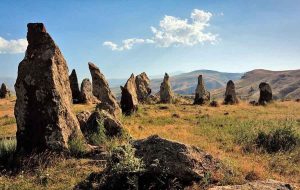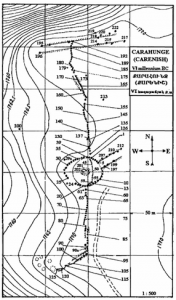 Karahunj (Zorats Karer) is an ancient site in southern Armenia that contains more than 230 large stones, some 37 still standing, arranged in a fashion that has suggested to many observers that it was used for archaeoastronomy. But defining how it was used has remained elusive. Complicating the situation, Karahunj is located near a complex of ancient graves; we do not know who built it; it is difficult to ascertain exactly when the stones were set up; and some 85 of them have holes drilled through them that researchers have suggested might be used for sighting celestial objects, but other researchers think this unlikely because they would have been too imprecise.1
Karahunj (Zorats Karer) is an ancient site in southern Armenia that contains more than 230 large stones, some 37 still standing, arranged in a fashion that has suggested to many observers that it was used for archaeoastronomy. But defining how it was used has remained elusive. Complicating the situation, Karahunj is located near a complex of ancient graves; we do not know who built it; it is difficult to ascertain exactly when the stones were set up; and some 85 of them have holes drilled through them that researchers have suggested might be used for sighting celestial objects, but other researchers think this unlikely because they would have been too imprecise.1
Nonetheless, there is a rather simple explanation of the stones of Karahunj. But to grasp it, one must become aware of the compelling new evidence for and reinterpretation of the Venus theory of Immanuel Velikovsky. We now know that, although he made plenty of pioneer’s mistakes, Velikovsky was wonderfully right in his book Worlds in Collision2 that Venus repeatedly approached Earth as a comet in the Bronze Age, and their gravitational interaction caused devastation throughout the world (Venus had been pulled by Jupiter’s gravity from the outer solar system).
Peoples worldwide sought to propitiate the fearsome god/goddess by building an effigy of Venus that the passing comet could view from above while also tracking it and conducting rituals (at times, human sacrifices) to propitiate it. These sites had a number of telltale characteristics that differentiate them from a normal solar observatory, though observation of the Sun might also have taken place at such Venus sites. Karahunj has three such characteristics. First, the stone ring at its center forms an oval (it is sometimes reported as a circle, and on the map one can see the tracing of a circle. But the stones form an oval.). When Venus was pulled by Jupiter’s gravity into the inner solar system around 2525 BC, tidal heating turned it into a molten, ovoid comet. Some Venus effigies depicted it as a serpent with a long tail; the Great Serpent Mound in Ohio showed the serpent with an egg (an oval) in its mouth.
while also tracking it and conducting rituals (at times, human sacrifices) to propitiate it. These sites had a number of telltale characteristics that differentiate them from a normal solar observatory, though observation of the Sun might also have taken place at such Venus sites. Karahunj has three such characteristics. First, the stone ring at its center forms an oval (it is sometimes reported as a circle, and on the map one can see the tracing of a circle. But the stones form an oval.). When Venus was pulled by Jupiter’s gravity into the inner solar system around 2525 BC, tidal heating turned it into a molten, ovoid comet. Some Venus effigies depicted it as a serpent with a long tail; the Great Serpent Mound in Ohio showed the serpent with an egg (an oval) in its mouth.
Second, Venus’ large body blacked out the central part of its tail. People in the Near East thought the tail’s bright sides were horns, so they called Venus the Bull of Heaven. Similarly, various peoples termed Venus a bird, with bright wings instead of horns. In China, one of its many names was the Vermilion Bird. At Karahunj the stones form a reasonable facsimile of a large raptor bird with long wings. The right wing bends back at the end; the left one seems at its end to bend forward, or at least to be somehow complex. One interpretation of Karahunj as a bird effigy is that the long straightness of its wings was not based on its actual appearance; the two visible sides of Venus’ tail were probably more swept-back than Karahunj shows. Conversely, the builders may have sought to replicate the complicated configuration of what they saw in the sky at one time at the end of the left wing; the tail of Venus could have repeatedly twisted in response to the solar wind.
Third, an alley of stones extends from the oval in a northeast direction that has been interpreted as the winter solstice, the major lunistice, or the rising point of Venus. On the map it is evident that in the opposite direction the stone oval is also interrupted, and a single stone stands outside in the center of the direction opposite to the alley. Whether the alley would be used for other purposes, this interpretation would have it primarily intended to track Venus at the horizon.
However, here a tricky question of dating arises. Evidence and theory suggest that Venus approached Earth particularly closely on four occasions, and in response Earth inverted. These were the greatest of the Bronze Age catastrophes, and they appear to have occurred around 2200, 1628, 1210, and 820 BC.
Therefore, from 2200 to 1628 BC, Venus would have risen with the Sun in the West. Then, from 1628 to 1210 BC in the East again. Then from 1210 to 820 BC in the West again. And finally, after 820 BC, in the East.
A second tricky question arises from the consideration that Venus appeared as both Morning Star/Comet and Evening Star/Comet. While tracking of the rise of Venus in the morning, especially its heliacal rise, was definitely of interest, the ancients seem to have considered the Evening Star/Comet as the more dangerous of the two and thus more worth tracking. Also, its last setting along the horizon before it disappeared was farther from the Sun than the rising of the Morning Star/Comet.
A parallel instance can help us think about the alignments at Karahunj. Taosi site in China was evidently also primarily a Venus observatory. The alignments of its viewing slots make no sense for observing the Sun. When Taosi was operating in the period around 2100 to 1900 BC, Venus was rising in the West. Yet the site is oriented toward the East. This suggests that the Chinese astronomers were tracking the setting points of the Evening Star/Comet.3 Another parallel is with Stonehenge, also a Venus site.
Thus Karahunj can perhaps best be interpreted as primarily a Venus observatory site, like Taosi, that was built following the inversion of 2200 BC; and the alley was oriented toward east northeast, the farthest setting point of the Evening Star/Comet. However, the alley may be wide enough to permit observation of the setting summer solstice Sun as well during eras of a western-rising Sun. While Comet Venus was awe-inspiring, so was a Sun that rose in the west.
And the holes in the stones? When the wind blows, they give off a singing sound. As if from a giant bird?4
*****
Kenneth J. Dillon is an historian who writes on science, medicine, and history. See the biosketch at www.scientiapress.com/about-us. For further detective work on ancient and modern history, see his The Knowable Past (Washington, D.C.: Scientia Press, 2018).
